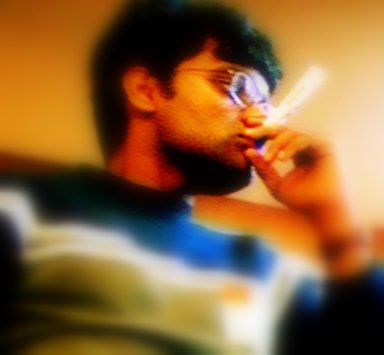Memoirs of a village life

“Sastha is coming this way”, the local village kid cried while running. That was not a shrilling holler. It was nothing more than a shout which a boy of fourteen can give while huffing and puffing his way through the alleys. But all the people in the village came out as if they were expecting someone to yell those words around that time. Sastha is the local deity which is believed to be the protector of the village. The priest, who does the rites in the small temple under a banyan tree 3 miles from the residential area, is considered a living deity on special days. And that day, lunar New Year was one such day.
Residential area is a stretch-word for the 300 something modest homes in Beemanagari, a village of around 1000 people at the southern tip of India. Two of those houses were rented for municipal offices and one was dedicated as the local post office. These offices were almost always locked up. The mails for the residents of this village came from the nearest town. Those mails are few and infrequent and the head of the local post office lived in the town. His wife could not handle the stringencies of the village and goaded him to make the move to the town. The post master employed the services of his home servant to dispatch the local mails.
In addition to being the New Year, that day, the village head wanted the priest to perform a special rite for saving his 15 year old from the hands of the death angels. As is the custom among the wealthy farm land owners of the village, the head’s son is educated in Madras, a metro known for good schools. He was a spoilt brat who is fit neither for farming nor for academics. His only claim to fame was being the only son of a wealthy man. He was often surrounded by head’s thugs and senile village council members who pampered him to get favors from his father. The son got into the village water tank armed with the swimming capability of a heavy lead ball. A farmer’s son who was around that area spotted him drowning and he dragged him out of the well. While the village head attributed this ‘miracle’ to the local deity and called for the ceremony, the reward the real savior got was a deep bite mark from the imbecile son. Not many in the village opposed the ceremony, as any occasion is good enough to please the local deity.
As was the custom in the village, while the rites were performed, the residents could not go near the temple. Only the priest could talk with the deity and hence the excitement surrounding the homecoming of the priest. For the next few hours, the residents had to treat the priest with at most respect as he is Him personified. In reality, though, the priest was an incorrigible drunkard who was often seen in the fields after overnight drunken orgies with the thugs of the village well-to-dos. The softer, humbler and more modest residents of the village with values attributed this behavior to the end of times. “The dark side is taking over” they would observe and would mind their business. Even they would treat the priest with reverence on those special days and get the sacred ash from the priest. It wasn’t an irony that was overlooked. It is the way the cookie crumbles in the village, except that there are no cookies in our village in India.
Even in this modest village the cuisine is very indigenous and rich. White Bread is considered as the diet of a recuperating patient and biscuits are something that the Englishmen eat because their lazy women don’t do real cooking. At least 5 vegetable curries are present in daily lunch with rice, sambar, rasam and thayir (Calling them lentil soup, tomato soup and yogurt is unconscionable and akin to butchering mercilessly, the carefully prepared food items). The staple food is rice and the village women would boast of 200 odd recipes using rice - coarse ground, powdered, boiled, half-boiled, par-boiled or fried. Somehow, the Atkins fad never caught up in our village. One would better not bring the topic of low calorie diet lest one be relegated as a city slacker. Even though the farmers live penuriously compared to the standards of the city, the farm products are aplenty. Rice need not be slow cooked with a special setting in Betty Crocker. The rice in boiling water fueled by burning logs can be cooked no sooner than 75 minutes for 4 servi
 ngs. The women are all home makers and they take huge pride in their culinary skills. A typical day starts at 5 AM long before the men wake up and lasts until 9PM long after they hit the sack. Apart from the daily chores, there isn’t much time for anything and they seemed to care less of the fact. Sastha ceremony is much anticipated by the kids not for any spiritual reasons but for a more mundane reason – lot of different variety of foods. The whole village gets together in a public hall and the sumptuous feast is enjoyed almost in a manner identical to that experienced by the ancestors a thousand year earlier.
ngs. The women are all home makers and they take huge pride in their culinary skills. A typical day starts at 5 AM long before the men wake up and lasts until 9PM long after they hit the sack. Apart from the daily chores, there isn’t much time for anything and they seemed to care less of the fact. Sastha ceremony is much anticipated by the kids not for any spiritual reasons but for a more mundane reason – lot of different variety of foods. The whole village gets together in a public hall and the sumptuous feast is enjoyed almost in a manner identical to that experienced by the ancestors a thousand year earlier.Nothing much changes in the village. The daily chores happen without the aid of electricity and the activities are dictated by the rising and setting of the Sun. Because of the proximity to the Equator, the days neither grow longer nor shorter. Beemanagari is surrounded by impressive mountains (~2500-5000 feet peaks). Because of the presence of mountain passes, we get very strong winds. People sleep out in the open enjoying the bliss of the pleasant breeze. To answer nature calls in the night, people use hand held torches - wooden log fueled by kerosene. That’s pretty much the technology used in the village. If you are a light sleeper, you can see a lot of Statues of Liberties walking past you. Occasionally you hear someone giving a heads-up on a snake that has creeped in from the fields. That didn’t discourage people from sleeping in the open. The village druid - more of a witch doctor, is a famous personality in the village for obvious reasons - the MBBS doctor is in the town and it will take 3 hours before a patient can be taken to the town. The Indian government’s goal of electrifying every village, town and city hasn’t reached this far and no one seemed to complain about that.
School is a luxury that can be afforded only by the wealthy or by the perseverant, with empathetic parents. The nearest school with higher secondary education is 8 miles away in the next village and one has to cover the distance by foot. If you are the son of a wealthy person, then you get the privilege of getting higher education in quality schools in the metro 300 miles away. A local majordomo is sent with those kids to alleviate their tribulations away from home. If you don’t take up education, the path of least resistance is to learn farming from the parents or become one of the thugs under the wealthy. Men also took up cooking profession and traveled many miles to cater to marriages and other functions. My family was very supportive in giving me education. I did my schooling in the next village and got into an engineering program in a city 150 miles from the village. I was treated to a hero’s welcome every time I returned home for the semester holidays. Now, after finishing my masters and taking up a job in the valley, I am even farther away from my village. But in one of those rare moments away from the maniacal deadlines imposed by my profession, when I have time to muse, my mind wanders and my heart yearns for the western breeze from the mountain passes, for the love of simple minded but big hearted denizens of the village. If I concentrate hard, I can even smell the rusticity of Beemanagari and the sacred ash from Sastha’s temple. If I concentrate harder, I can even hear my own voice, “Sastha is coming this way”, while huffing and puffing my way through the alleys years ago; for, I was that local village kid.
Peace out
yours truly
ps. I submitted this work for Cupertino Library Rural Scribe competition and am glad to say that they published this in their newsletter. I also got an opportunity to read the article infront of the Cupertino community audience in the city hall.

3 Comments:
Fascinating story. I had no idea you were raised in a village (or is it just a tall tale?). I was born in Bangalore and grew up in the city (except for a brief stint in Goa) and a city boy through and through.
I spent a large part of my working life in the North (U.P. and I hated every moment of it).
Your description of village life seems idyllic--must be something special to South India. But then the only villages I have seen are the impoverished, desolate and hopeless villages of North India--can't say I was impressed. But then the North Indian cities were nothing to write home about either.
Good writing, though.
One is taken on a great Nostalgic experience on reading this article. Truly deserving one. Keep it up
Gurunathan Raman
Beemaneri is a genuinely idyllic village amidst pristine location, even today.
Excellent Narrative!
Post a Comment
<< Home